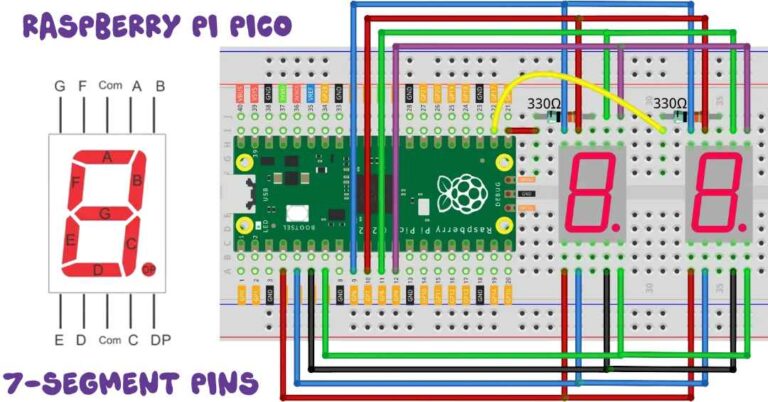🧠 Ultimate Guide to 7-Segment Display (Beginner-Friendly) 7-Segment Display Explained for Students | Projects, Code, and Diagrams
“Turn numbers into light! Learn how 7-segment displays work and build your own digital counter!”
📌 Table of Contents
- What is a 7-Segment Display?
- Why is it Called “7-Segment”?
- Types of 7-Segment Displays
- Pin Diagram and Internal Structure
- How Does it Work?
- Common Anode vs. Common Cathode
- Interfacing 7-Segment Display with Microcontrollers
- Displaying Numbers: Segment Code Table
- Code Example (with Explanation)
- Real-life Projects Using 7-Segment Displays
- FAQs for Students
- Final Words + Downloadable Resources
🔍 1. What is a 7-Segment Display?
A 7-segment display is an electronic display device used to show numbers using 7 LEDs arranged in a special figure-eight pattern. It is most commonly used in digital clocks, meters, and counters.
🌈 2. Why is it Called “7-Segment”?
Because it is made up of 7 individual segments (small LEDs) named:
a,b,c,d,e,f, andg
These segments can be turned ON or OFF to form different numbers.
💡 Fun Fact: Some 7-segment displays also have an eighth segment for the decimal point (called dp).
🔍 3. Types of 7-Segment Displays
✅ Based on Circuit Type:
- Common Anode
All LED anodes (+) are connected together.- You give LOW (0) to turn a segment ON.
- Common Cathode
All LED cathodes (–) are connected together.- You give HIGH (1) to turn a segment ON.
🛠️ Always check the datasheet before connecting to avoid damage!
🔌 4. Pin Diagram and Internal Structure
Most 7-segment displays have 10 pins.
Here’s how it looks:
| Segment | Pin | Function |
|---|---|---|
| a | 7 | Controls segment a |
| b | 6 | Controls segment b |
| c | 4 | Controls segment c |
| d | 2 | Controls segment d |
| e | 1 | Controls segment e |
| f | 9 | Controls segment f |
| g | 10 | Controls segment g |
| dp | 5 | Decimal point |
| COM | 3, 8 | Common pin |
⚙️ 5. How Does it Work?
To display a number:
- You light up the correct combination of segments.
- For example:
- Number
2= a + b + g + e + d - Number
4= f + g + b + c
- Number
The controller sends signals to turn ON/OFF segments based on a pattern.
🔁 6. Common Anode vs. Common Cathode
| Feature | Common Anode | Common Cathode |
|---|---|---|
| Wiring | Connect all anodes to Vcc | Connect all cathodes to GND |
| Segment ON | Send LOW | Send HIGH |
| Easy to Use | With PNP or Source drivers | With NPN or Sink drivers |
🖥️ 7. Interfacing with Microcontrollers
You can control a 7-segment display using:
- Arduino
- Raspberry Pi
- ESP8266/NodeMCU
- Raspberry Pi Pico
Example (ESP8266/NodeMCU in MicroPython):
pythonCopyEditfrom machine import Pin
import utime
segments = [Pin(i, Pin.OUT) for i in range(8)] # a to dp
number_2 = (1, 1, 0, 1, 1, 0, 1, 0) # pattern for digit 2
for seg, val in zip(segments, number_2):
seg.value(val)
🧠 Explanation:
- Each LED is controlled using a pattern of
1sand0s. - We use a
forloop withzip()to match each pin with its value.
🔢 8. Segment Code Table
| Digit | a | b | c | d | e | f | g |
|---|---|---|---|---|---|---|---|
| 0 | 1 | 1 | 1 | 1 | 1 | 1 | 0 |
| 1 | 0 | 1 | 1 | 0 | 0 | 0 | 0 |
| 2 | 1 | 1 | 0 | 1 | 1 | 0 | 1 |
| 3 | 1 | 1 | 1 | 1 | 0 | 0 | 1 |
| 4 | 0 | 1 | 1 | 0 | 0 | 1 | 1 |
| 5 | 1 | 0 | 1 | 1 | 0 | 1 | 1 |
| 6 | 1 | 0 | 1 | 1 | 1 | 1 | 1 |
| 7 | 1 | 1 | 1 | 0 | 0 | 0 | 0 |
| 8 | 1 | 1 | 1 | 1 | 1 | 1 | 1 |
| 9 | 1 | 1 | 1 | 1 | 0 | 1 | 1 |
🛠️ 9. Cool Projects Using 7-Segment Display
- Digital Counter
- Temperature Display
- Dice Simulator
- Stopwatch
- Scoreboard Display
💡 Tip: Combine multiple 7-segments to display multi-digit numbers!
❓ 10. FAQs for Curious Students
Q: Can I connect a 7-segment display directly to a battery?
A: Not recommended. Use resistors to protect the LEDs.
Q: What’s the difference between 7 and 14-segment displays?
A: 14-segment displays can show letters and symbols too!
Q: Why doesn’t my segment light up?
A: Check if:
- You’re using the correct common type (anode/cathode)
- Pin numbers are correct
- You added current-limiting resistors
🎉 11. Final Words
A 7-segment display is a classic and powerful tool to visualize data like numbers. Whether you’re building a digital clock or making a fun microcontroller project, understanding how it works gives you a strong foundation in electronics.
📥 Bonus: Downloadable 7-Segment Display Poster for Students
(Include a colorful printable PNG showing segment labels and patterns for all digits)



